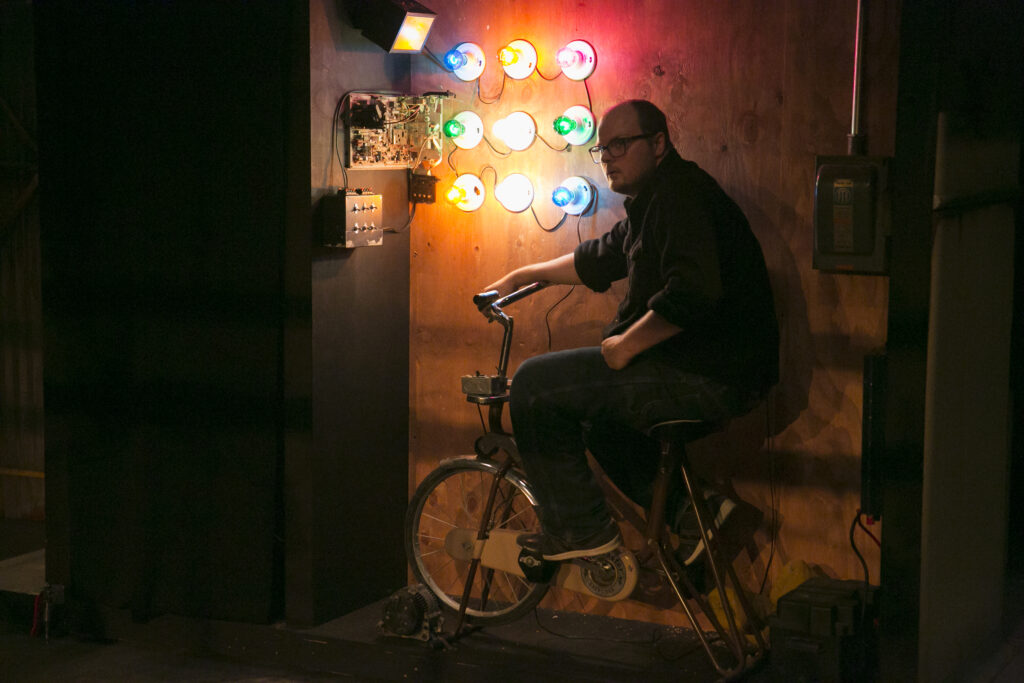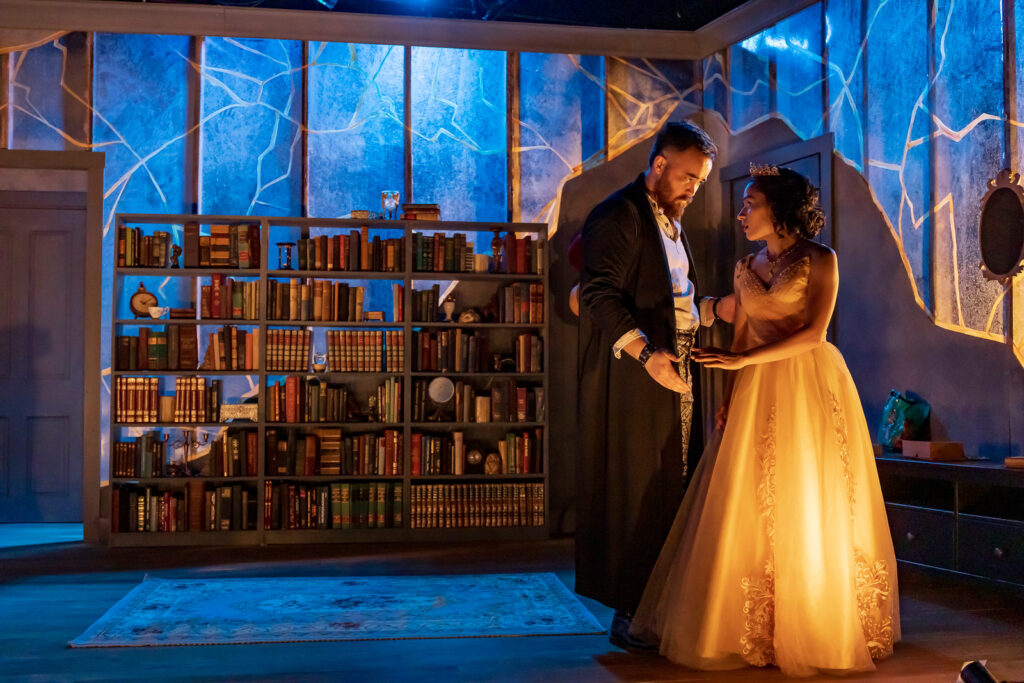by Monica Cross

In his 2014 keynote at Stage the Future: The First International Conference of Science Fiction Theatre, Tom Hunter, Director of the Arthur C. Clarke Award, coined the term Replicant Theater, taking the name from the bio-engineered humanoids of Blade Runner. Just as a Replicant passes so fully as human that they may not even realize they are not human, Hunter posited that there are elements of science fiction that have such a long history on stage that we don’t even think about them as being anything other than theater. These elements are so often reproduced without recognition or acknowledgment of their science fiction roots that it is impossible to create a comprehensive list of science fiction plays. Nor is that the project of this article. Instead, the following is a look at a few science fiction and fantasy plays that tell stories with unique qualities that make them inherently well-suited for the stage over any other medium.
A common criticism of the SFF theater states that a play will always, by its nature, fall short of the special effects of television and never live up to the theater-of-the-mind experience of reading. What this view of SFF theater fails to realize is that the theater provides an immediacy and intimacy that can be used to invigorate certain types of SFF stories and themes. Therefore, just as some stories work best as graphic novels or video games, some as novels or short stories, and still others as movies or television, the plays discussed in this article are stories that have found their optimal form on stage.
Certain SFF tropes and subgenres are particularly well suited to the stage and often appear in plays that are firmly situated within SFF genres as well as plays that do not acknowledge their SFF roots.
- dystopian near-futures (Far Away by Caryl Churchill and The Pillowman by Martin McDonagh. In fact, most of the plays of the British movement of the late 1990s known as In-Yer-Face theater could be described as dystopian.)
- stories where one person can play different iterations of the same people as long as they don’t have to meet (A Number by Caryl Churchill features one actor playing multiple clones, and in Constellations by Nick Payne, the audience sees the two characters’ relationship across several alternate realities.)
- stories that physicalize a metaphor (Rhinoceros by Eugène Ionesco, where herd mentality leads to people becoming animals, and Melancholy Play by Sarah Ruhl, where a person becomes so depressed that they transform into an almond.)
- new work that incorporates myth, folklore, and fairy tales
The following are four standout plays of the last two decades that are creating new theatrical conventions that illuminate the future possibilities of SFF theater. In discussing the innovative staging of each SFF play, there will be spoilers for those scripts.
The Mountaintop by Katori Hall (2009)
The Mountaintop is chiefly important for its discussion of race and civil rights in the United States, and in fact, it’s not generally categorized as fantasy. However, it is the fantastical elements of the script that make its civil rights message so powerful. The play is a great example of how the best SFF uses the SFF elements in the story to amplify a greater message. It makes unmistakable use of the fantastical elements of magical realism and beautifully glides from what at first seems like naturalism to a moment where Dr. Martin Luther King, Jr., having been shown the trajectory of the civil rights movement from his death to the present moment, directly addresses the audience with a new call to activism.
Mr. Burns, a Post-Electric Play by Anne Washburn (2012)
By using the term Post-Electric to describe the post-apocalyptic play, this script somewhat sidesteps usual science fiction categorization. However, it is set in an indeterminate near-future, where we find out most people have died, cities have burned, and the nuclear power plants may not have been shut down properly before everything went offline. Each act continues to progress further into the future: first, seven years for Act Two, then another 70 years for Act Three. The third act is a play-within-a-play retelling of the fall of civilization through the lens of The Simpsons. The lack of an on-stage audience for this play-within-a-play removes any mediation or framing that might occur in the third act, leaving the audience feeling as if they have been transported 77 or so years into the future.

Marjorie Prime by Jordan Harrison (2014)
In the introduction to a regional production of Marjorie Prime, I saw a theatermaker describe the play as being about the human condition, “despite” being science fiction. From my seat in the intimate theater, I may have visibly cringed at the assumptions made in that statement. This play focuses on Primes, which are exact replicas of dead loved ones. Set up as a living-room drama, this play creates a careful examination of memory, identity, and relationships.
Glassheart by Reina Hardy (2022)
This contemporary urban riff on the Beauty and the Beast story focuses on an anthropomorphic lamp who has loyally brought the beast to Chicago in the hopes that a new environment will help break the curse. The lamp mistakenly believes that she will become human along with the beast when the curse is broken, but comes to realize that as a lamp, she will return to an inanimate state if the curse is ever lifted. She is tempted by a witch to assume the life of a young woman who becomes trapped in the beast’s apartment as a means of attaining some measure of the humanity she seeks.

The key element that makes each of these plays so effective is the fact that actors and audience are all living and breathing in a shared space, creating the story together. The science fiction and fantasy elements of the story are experienced in a visceral way that offers a new way to engage with the concepts that SFF writers have always grappled with.
Explore more articles from SFF on Screen and Stage
 Monica Cross is a playwright based out of Wisconsin. She has an extensive background in theater, including acting, directing, dramaturgy, and design.
Monica Cross is a playwright based out of Wisconsin. She has an extensive background in theater, including acting, directing, dramaturgy, and design.
Monica has taught at New College of Florida, Ringling College of Art and Design, and University of South Florida, St. Petersburg. She has worked at the American Shakespeare Center, Urbanite Theatre, and Wisconsin Shakespeare Festival.
Monica’s plays have been produced by Silk Moth Stage, Whiskey Theatre Factory, The Sarasota Players, MadLab, Theatre Odyssey, The Hippodrome, and various Fringe Festivals across the United States. Her work has been a semifinalist for the O’Neill National Playwrights Conference and Shakespeare’s New Contemporaries, and a finalist for Wisconsin Wrights. Her writing has been published in The Best 10-Minute Plays 2023, The Best Men’s Stage Monologues 2024, The Best Men’s Stage Monologues 2025, and The Best Women’s Stage Monologues 2025 (all through Smith & Kraus), as well as Ten-Minute Play Festival, Volume Four: 2018 – 2021 by Theatre Odyssey.
Monica holds an M.Litt. and MFA from Mary Baldwin College and has most recently trained at the Kennedy Center Summer Playwright Intensive. In addition to being a member of the Science Fiction and Fantasy Writers Association, she is also a member of the Dramatists Guild. For more, visit her website at www.monicacross.com and her portfolio on NPX.
